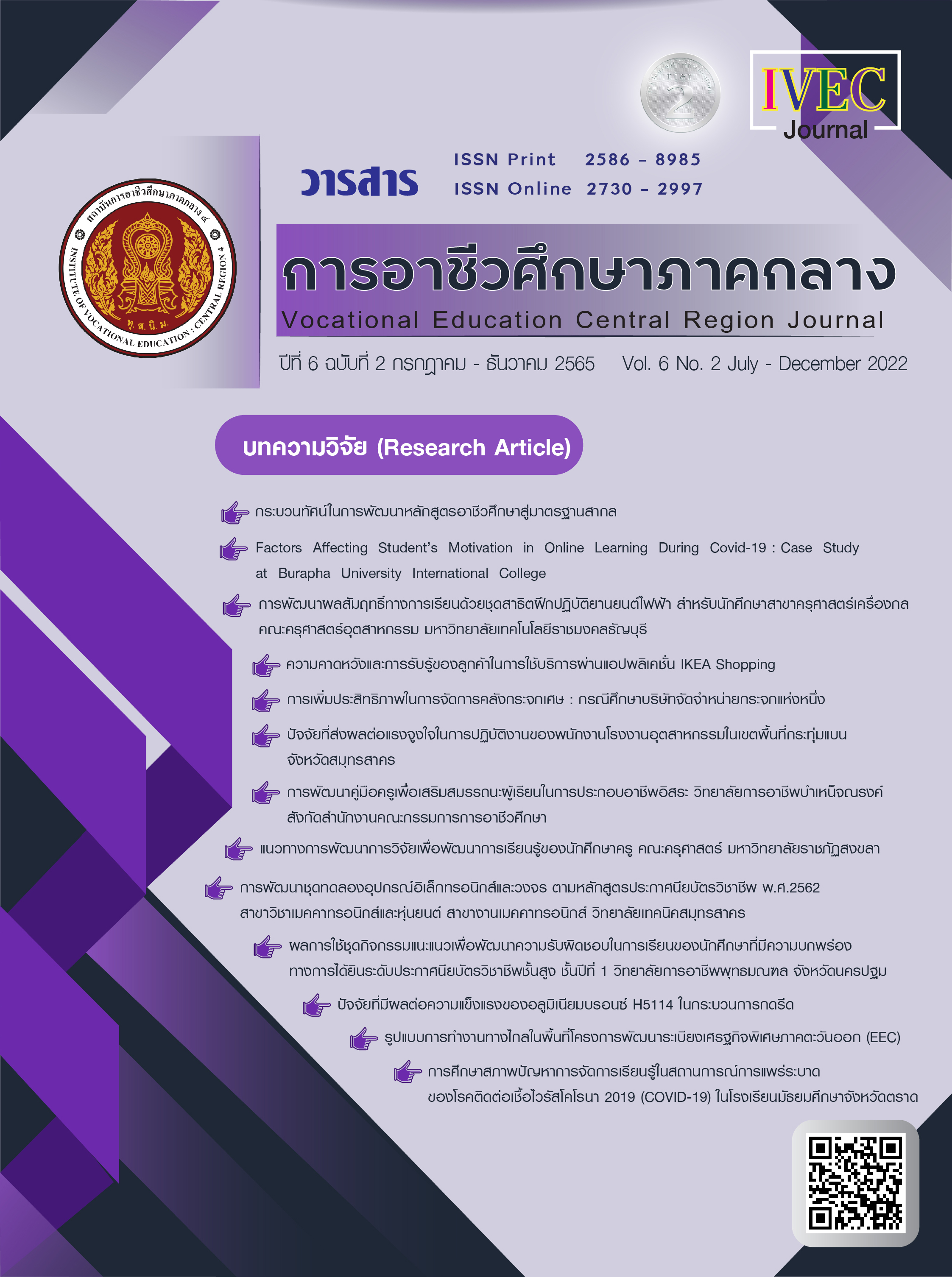Remote Working Model in Eastern Economic Corridor Area
Main Article Content
Abstract
The objective of this research was to survey the situation, analyze and synthesize the guidelines for working remotely in the area of the Eastern Economic Corridor (EEC) development project by collecting questionnaires from the total 385 people sample group by convenience sampling method (Convenience Sampling). The results showed that most respondents had a high level of knowledge and understanding about working remotely. Furthermore, compared before the epidemic situation (COVID-19) to the current situation, employees performance was at the same level. However, compared to the period before COVID-19, Wave 1 (during March 2020), Wave 2 (late December 2020), and Wave 3 (April 2021 onwards), the best performance was before the epidemic situation and got worse over time. Therefore, less travel time was essential for effective remote working during a pandemic. in contrast, feelings of isolation and lack of communication with anyone were the most important factors for ineffective working remotely in epidemic situations (COVID-19). The efficiency of the organization's management in the situation of the COVID-19 epidemic was at a moderate level. Employees felt that childcare benefits support was the least effective. The most crucial reason for returning to the office was meeting and interacting with colleagues. And 49.61 % would like to work remotely from time to time (e.g., twice a month).
Article Details

This work is licensed under a Creative Commons Attribution-NonCommercial-NoDerivatives 4.0 International License.
|
บทความ ข้อมูล เนื้อหา รูปภาพ ฯลฯ ที่ได้รับการตีพิมพ์ในวารสาร การอาชีวศึกษาภาคกลาง ถือเป็นลิขสิทธิ์ของวารสารการอาชีวศึกษาภาคกลางหากบุคคลหรือหน่วยงานใดต้องการนำทั้งหมดหรือส่วนใดส่วนหนึ่ง ไปเผยแพร่ต่อหรือเพื่อกระทำการใด ๆ กองบรรณาธิการไม่สงวนสิทธิ์ ในการคัดลอกบทความเพื่อการศึกษาแต่ให้อ้างอิงแหล่งที่มาให้ครบถ้วน สมบูรณ์ สงวนสิทธิ์ โดย สถาบันการอาชีวศึกษาภาคกลาง 4 ที่ตั้ง 90 ถนนเทศา ตำบลพระปฐมเจดีย์ อำเภอเมือง จังหวัดนครปฐม โทรศัพท์ 034 242 856 , โทรสาร 034 242 858 ISSN : 3056-9176 (print) ISSN : 2985-2382 (online) |
References
กรมควบคุมโรค. (2564). มาตรการเฝ้าระวังป้องกันและควบคุมโรคโควิด 19 สำหรับผู้ประกอบสถานประกอบการ. ค้นเมื่อ เมษายน 30, 2563, จาก https://ddc.moph.go.th/viralpneumonia/file/int_operator/int_operator23_050164.pdf
ธีรยุส วัฒนาศุภโชค. (2553). Entrepreneurship : ฤาจะเป็นฟางเส้นสุดท้ายต่อระบบเศรษฐกิจไทย. ค้นเมื่อ กันยายน 30, 2565, จาก http://www.mbachula.info/page_detail.asp?nid=54
Bailey, D. E., & Kurland, N. B. (2002, June). A Review of Telework Research: Findings, New Directions, and Lessons for the Study of Modern Work. Journal of Organizational Behavior, 23, (4), pp. 383-400.
Best, J. W. (1981). Research in Education. (4th ed.). New Jersey: Prentice–Hall Inc.
Bloom, N., Liang, J., Roberts, J., & Ying, Z. J. (2015). Does Working from Home Work? Evidence from a Chinese Experiment. The Quarterly Journal of Economics, 130, (1), pp.165–218.
Collins, C., Landivar, L.C., Ruppanner, L., Scarborough, W. J. (2020). COVID‐19 and the gender gap in work hours. Gender Work & Organization, 28, (S1), pp. 101-112.
Feleen, C. J., V, V., Kalgi, N., David, A., M, M., & M, C., (2021). A Comparative Study of Work From Home vs Work From Office: Preference of Women Employees in IT Industry. Design Engineering, 7, (1), pp. 5763-5775.
Harpaz, I. (2002, Apr). Advantages and disadvantages of telecommuting for the individual, organization and society. Work Study, 51, (2), pp. 74-80.
Heggeness, M. L. (2020). Estimating the immediate impact of the COVID-19 shock on parental attachment to the labor market and the double bind of mothers. Rev Econ Household, 18, (4), pp. 1053–1078.
Kibbe, M. R. (2020). Consequences of the COVID-19 Pandemic on Manuscript Submissions by Women. JAMA Surgery, 155, (9), pp.803-804.
Kirkman, B. L., & Mathieu, J. E. (2004). The role of virtuality in work team effectiveness. In Academy of Management Annual Meeting Proceedings 2004 (August). New York: Briarcliff Manor.
MIT Sloan School of Management. (2020). How to manage the hidden risks in remote work. ค้นเมื่อ สิงหาคม 15, 2565, จาก https://mitsloan.mit.edu/ideas-made-to-matter/how-to-manage-hidden-risks-remote-work
Mustajab, D., Bauw, A., Rasyid, A., Irawan, A., Akbar, M. A., & Hamid, M. A. (2020). Working From Home Phenomenon As an Effort to Prevent COVID-19 Attacks and Its Impacts on Work Productivity. TIJAB (The International Journal of Applied Business), 4, (1), pp.13–21.
Van der Lippe, T., & Lippényi, Z. (2020). Co-workers working from home and individual and team performance. New Technology, Work and Employment, 35, (1), pp. 60-79.
Wu, H., & Chen, Y. (2020). The Impact of Work from Home (WFH) on Workload and Productivity in Terms of Different Tasks and Occupations. In 22nd International Conference on Human Computer Interaction (19-24 July pp. 693-706). Denmark: Copenhagen.


